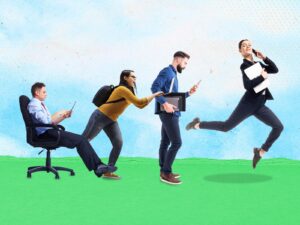
In a recent episode of Moneypenny’s On the Up podcast, we welcomed workplace design experts Emma Armstrong and Donna Uden from Empro for a rich and revealing conversation about the evolution of the workplace. From typing pools and smoke-filled boardrooms to inclusive spaces and even dog crèche requests, the discussion brought home just how far we’ve come, and what lies ahead.
When Donna Uden started her career at London Weekend Television (now ITV), the office setup was worlds apart from what we see today.
“I joined the typing pool, the script typing pool, with rows and rows of desks, the typist supervisor sitting on the front, on the desk, on a platform so she could keep an eye on all this,” she shared.
This kind of rigid structure wasn’t just about workflow; it reflected a broader mindset around supervision and hierarchy. The office layout itself made clear who was in charge and who wasn’t.
Gender segregation was also built into the workplace, both culturally and physically. While working on a historical building renovation, Donna found a small room next to the boardroom. “Apparently the secretary had to sit in there to take the minutes because no women were allowed in the boardroom.”
Segregation wasn’t the only defining feature of past office culture, so were environmental norms that would be unacceptable today.
“Smoking rooms. Yes. Smoking in offices. I remember that when I first started work,” Donna said.
Before public health policies caught up in the early 2000s, many offices were filled with cigarette smoke. The shift to designated smoking rooms, and eventually total bans, mirrored broader changes in how society values shared space, health, and wellbeing.
One of the biggest shifts in office design has been the focus on inclusion and accessibility. It’s not just about ramps and lifts, it’s about listening to lived experiences.
Emma explained, “I’ve been in a wheelchair before, and I can fully understand now some of the issues and how inaccessible some of our infrastructure is.”
This perspective helped shape Empro’s partnership with the charity Treloar and their initiative “Let Me In,” where individuals with mobility issues visit offices to conduct real-life accessibility audits.
“Somebody from a local site will actually come and visit your site and do an audit of how accessible your building is,” she said. “And this will be from somebody who has an issue with mobility.”
The pandemic didn’t just push remote work forward; it reshaped how employees think about their offices and what they expect from them.
Emma recalled a post-Covid office project: “We were doing some end user engagement… Some of the team were asking for, not a human crèche, but a dog crèche… We’ve all got puppies now. We can’t just come back into the office. What are we going to do with our dogs?”
It might sound funny, but it speaks volumes. Personal life and work are more integrated than ever. And while a dog crèche didn’t make the final cut, many workplaces have adopted pet-friendly policies to boost morale and retention.
As offices move toward greater inclusivity, facilities like gender-neutral toilets have sparked conversation, and at times, resistance.
“One thing that caused the most debate was the gender-neutral toilets,” Donna recalled from an ITV relocation project. “People were very, very against them. But, once we moved in, after about a week, it all died down.”
What once seemed controversial quickly became routine. It’s a powerful example of how design can help normalise new cultural standards.
Today’s workplaces are more diverse than ever, with up to five generations working together under one roof. That can create challenges, but also opportunities.
“75% of the workforce will be millennials,” Donna noted. But she was quick to add, “It doesn’t mean people can’t change and evolve.”
Emma agreed. “We don’t like to be put in a box… I’m a millennial. Apparently, I should expect everything to be delivered at my feet, and I’m arrogant and this and that.”
Instead of designing for generational stereotypes, successful workplaces build in flexibility, for work styles, technology preferences, and collaboration.
Emma summed it up best: “The rate of change will never be as slow as it is today.”
Between AI, digital nomadism, and shifting views on work-life balance, the workplace is evolving fast. The transformation from typing pools and top-down control to open dialogue and dog crèches shows just how dramatically the role of the office has changed.
Emma added, “I think workforces are going to transform considerably… There’s an increase in entrepreneurial spirit and digital nomads, and people want to travel the world.”
Workplaces of the future will need to be adaptable, inclusive, and designed around human needs, not just productivity metrics.
For more insights on workplace evolution and creating spaces that drive business growth, listen to the full episode with Emma Armstrong, Donna Uden and our host Dan Marshall on the latest episode of Moneypenny’s On The Up podcast, available now on Spotify.
Your own PA to look after calls, qualify leads, book appointments, and lots more.
Discover >Our team of PAs capturing every new enquiry and qualifying them during the call.
Discover >